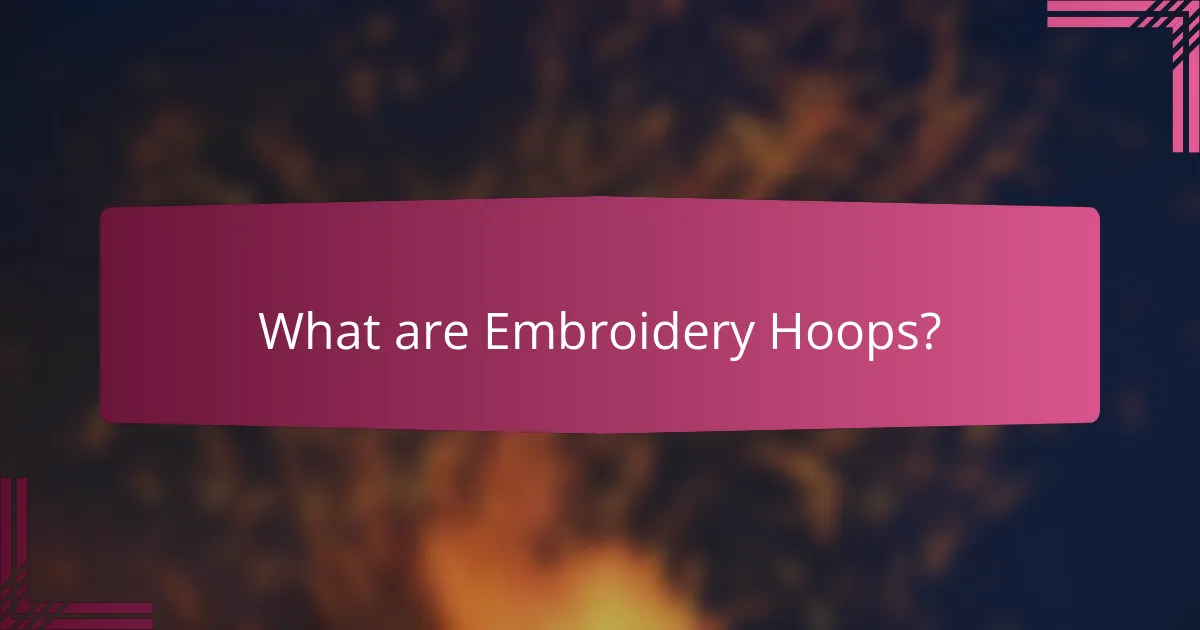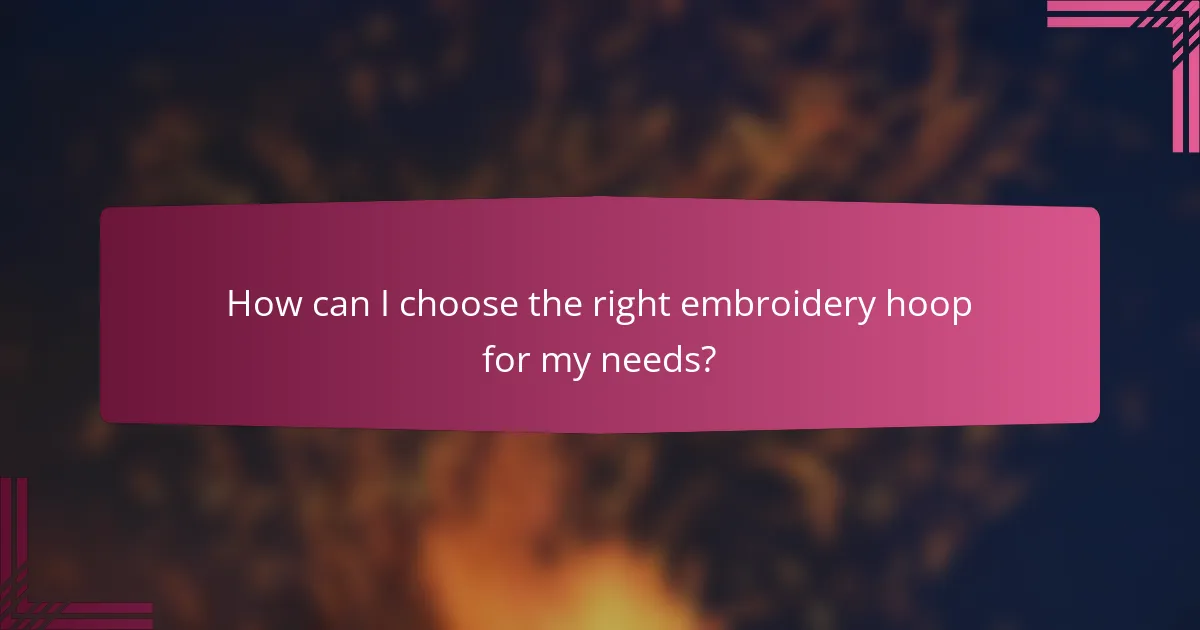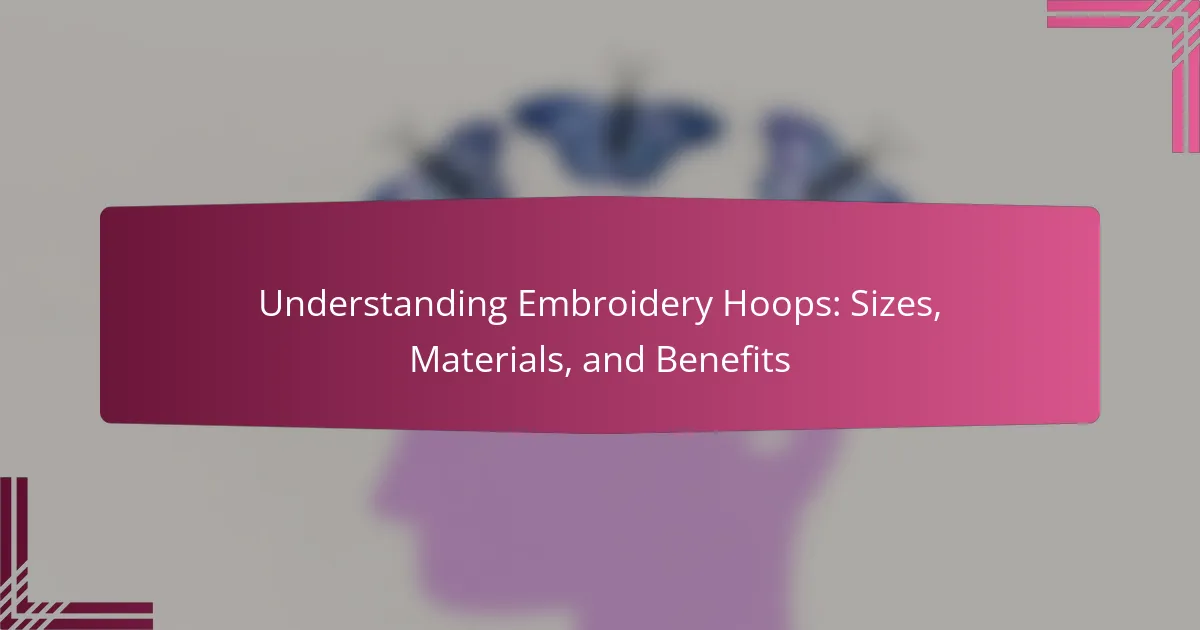
What are Embroidery Hoops?
Embroidery hoops are circular frames used to hold fabric taut while embroidering. They consist of two parts: an outer ring and an inner ring. The fabric is placed between these rings and tightened to ensure stability during stitching. These tools come in various sizes and materials, including wood, plastic, and metal. Embroidery hoops help maintain fabric tension, which is crucial for achieving even stitches. They are essential for both hand and machine embroidery projects. The use of hoops dates back centuries, highlighting their importance in textile arts.
How do Embroidery Hoops function in needlework?
Embroidery hoops function by holding fabric taut during needlework. This tension allows for precise stitching and prevents fabric distortion. The hoop consists of two circular frames, one of which fits inside the other. The outer frame secures the fabric, while the inner frame creates tension. This setup stabilizes the fabric, making it easier to work on intricate designs. Additionally, embroidery hoops come in various sizes to accommodate different projects. Using the correct size hoop enhances comfort and efficiency in needlework. Proper tension is essential for achieving clean, even stitches.
What are the key components of an embroidery hoop?
An embroidery hoop consists of two main components: an outer ring and an inner ring. The outer ring provides stability and support for the fabric. The inner ring holds the fabric taut for easy stitching. Both rings are typically made of wood, plastic, or metal. The two rings fit together securely to maintain tension on the fabric. Some hoops feature a screw mechanism for adjusting tension. This design allows for easy removal and replacement of the fabric. The combination of these components ensures effective embroidery practice.
How does the design of an embroidery hoop impact its usability?
The design of an embroidery hoop significantly impacts its usability. A well-designed hoop provides stability, ensuring that the fabric remains taut during stitching. This stability prevents puckering and distortion of the fabric. Additionally, ergonomic designs enhance comfort during prolonged use. Features such as adjustable tension allow for customization based on fabric thickness. Lightweight materials reduce strain on the hands. Furthermore, user-friendly closures simplify the process of securing fabric. Research indicates that a well-constructed hoop can improve stitching accuracy and reduce fatigue. These factors collectively enhance the overall embroidery experience.
What sizes do embroidery hoops come in?
Embroidery hoops come in various sizes, typically ranging from 4 inches to 14 inches in diameter. Common sizes include 4″, 6″, 8″, 10″, 12″, and 14″. Larger hoops, such as 16″ and 18″, are also available for bigger projects. The size chosen often depends on the design and fabric being used. Smaller hoops are ideal for intricate designs, while larger hoops accommodate bigger patterns or multiple elements. The availability of these sizes allows for flexibility in embroidery projects.
How do different sizes affect the choice of projects?
Different sizes of embroidery hoops significantly influence the choice of projects. Smaller hoops are ideal for detailed work and intricate designs. They allow for better control and precision in stitching. Larger hoops accommodate bigger patterns and provide more space for movement. This is especially useful for projects like quilts or large wall hangings. The size also affects fabric tension and stability during stitching. A properly sized hoop ensures that the fabric remains taut, which is crucial for even stitching. Choosing the right size can enhance the overall quality of the finished piece.
What are the common sizes available for embroidery hoops?
Common sizes available for embroidery hoops include 4 inches, 6 inches, 8 inches, 10 inches, and 12 inches in diameter. These sizes cater to various project needs. Smaller hoops, like 4 and 6 inches, are ideal for detailed work. Medium hoops, such as 8 and 10 inches, suit general embroidery tasks. Larger hoops, like 12 inches, accommodate bigger designs. The variety in sizes allows for flexibility in embroidery projects.
What materials are used to make embroidery hoops?
Embroidery hoops are primarily made from wood, plastic, and metal. Wooden hoops are often crafted from hardwoods for durability. Plastic hoops are lightweight and come in various colors and sizes. Metal hoops typically feature a spring mechanism for easy fabric tension adjustment. Each material offers unique benefits for different embroidery techniques. Wood provides a traditional feel, while plastic is favored for its versatility. Metal hoops are preferred for their strength and adjustability.
How do different materials influence the durability of embroidery hoops?
Different materials significantly influence the durability of embroidery hoops. Wooden hoops tend to be sturdy but can warp or crack over time. Plastic hoops are lightweight and resistant to moisture but may break under stress. Metal hoops offer high durability and strength, resisting bending or breaking. Each material’s properties affect how well the hoop maintains tension and shape during use. For instance, metal hoops provide consistent tension, making them ideal for intricate designs. In contrast, wooden hoops may require more maintenance to ensure longevity. Thus, the choice of material directly impacts the hoop’s performance and lifespan.
What are the advantages and disadvantages of plastic vs. wooden hoops?
Plastic hoops are lightweight, durable, and resistant to moisture. They are often less expensive than wooden hoops. Plastic hoops can provide a tight grip on fabric, which is beneficial for embroidery. However, they may not hold fabric as securely as wooden hoops for intricate designs.
Wooden hoops are generally more aesthetically pleasing and provide a traditional feel. They tend to grip fabric more securely, which can be advantageous for detailed work. However, wooden hoops can warp over time and are more susceptible to moisture damage. They are also typically heavier and more expensive than plastic hoops.

What are the benefits of using embroidery hoops?
Embroidery hoops provide stability and tension for fabric during stitching. This stability allows for more precise and even stitching. The tension keeps the fabric taut, preventing puckering. Using a hoop can improve the overall quality of the finished embroidery. Additionally, embroidery hoops come in various sizes, accommodating different project needs. They are typically made from wood or plastic, ensuring durability. Many crafters find that using a hoop reduces hand fatigue. Research indicates that proper tension and support can enhance embroidery outcomes significantly.
How do embroidery hoops improve stitching quality?
Embroidery hoops improve stitching quality by providing tension and stability to the fabric. This tension keeps the fabric taut, preventing puckering and distortion during stitching. A stable surface allows for more precise and even stitches. Additionally, hoops help maintain the fabric’s position, reducing the likelihood of mistakes. When the fabric is secure, the embroiderer can focus on the design without worrying about shifting. Studies show that using a hoop can lead to better stitch consistency and overall craftsmanship.
What role does tension play in the effectiveness of embroidery hoops?
Tension is crucial for the effectiveness of embroidery hoops. Proper tension keeps the fabric taut, preventing puckering and distortion during stitching. This tautness allows for more precise and even stitching, enhancing the overall quality of the embroidery. Insufficient tension can lead to loose fabric, causing uneven stitches and potential errors. Conversely, excessive tension may cause fabric damage or breakage of threads. Maintaining optimal tension is essential for achieving clean lines and intricate designs. Studies indicate that consistent tension improves stitch accuracy and reduces the likelihood of fabric shifting. Therefore, tension directly influences the final appearance and durability of the embroidery work.
How can using a hoop reduce fabric distortion?
Using a hoop can reduce fabric distortion by keeping the fabric taut during embroidery. This tension prevents the fabric from shifting or bunching as stitches are applied. When fabric is loose, it is more susceptible to puckering and warping. A hoop stabilizes the material, maintaining its shape and alignment. Research shows that using a hoop leads to more consistent stitch quality. This results in a cleaner, more professional finish on the final product. Proper tension management is crucial in embroidery for achieving optimal results.
Why are embroidery hoops essential for beginners?
Embroidery hoops are essential for beginners because they provide the necessary tension for fabric. This tension keeps the fabric taut, preventing distortion during stitching. A taut fabric surface allows for more precise and even stitches. Additionally, embroidery hoops help maintain the design’s integrity throughout the project. They are also user-friendly, making them ideal for those new to embroidery. Beginners can easily learn various stitching techniques with the support of an embroidery hoop. Furthermore, using a hoop minimizes frustration, allowing for a more enjoyable crafting experience.
What skills can beginners develop by using embroidery hoops?
Beginners can develop various skills by using embroidery hoops. These skills include hand-eye coordination, which improves as they learn to guide the needle accurately. They also enhance fine motor skills through the manipulation of fabric and thread. Beginners gain an understanding of basic stitching techniques, such as backstitch and satin stitch. They learn to read and follow patterns effectively, which boosts their comprehension skills. Additionally, beginners can develop creativity by experimenting with colors and designs. Using embroidery hoops also fosters patience and focus, as completing a project requires time and attention to detail. Each of these skills contributes to overall craftsmanship in embroidery.
How do embroidery hoops simplify the learning process?
Embroidery hoops simplify the learning process by providing stability and tension for fabric. This stability allows beginners to focus on their stitching techniques without the fabric shifting. Tension keeps the fabric taut, making it easier to see and follow patterns. Additionally, hoops come in various sizes, accommodating different projects. This versatility helps learners choose the right hoop for their specific needs. Using hoops can also reduce frustration, as they minimize errors caused by loose fabric. Overall, embroidery hoops serve as essential tools that enhance the learning experience for novice embroiderers.

How can I choose the right embroidery hoop for my needs?
To choose the right embroidery hoop, consider the size, material, and your specific project needs. Embroidery hoops come in various sizes, typically ranging from 4 inches to 14 inches in diameter. A larger hoop allows for bigger designs, while a smaller hoop is suitable for detailed work.
Material is another factor; wooden hoops provide a traditional feel, while plastic hoops are lightweight and often easier to handle. Ensure the hoop fits your fabric thickness well. A snug fit prevents puckering during stitching.
Also, consider the type of embroidery you will do. If working with intricate designs, a smaller, tighter hoop may be beneficial. For larger projects, a bigger hoop can accommodate more fabric.
Ultimately, the right choice aligns with your project requirements, personal comfort, and the type of embroidery technique you plan to use.
What factors should I consider when selecting an embroidery hoop?
When selecting an embroidery hoop, consider size, material, and tension. The size of the hoop affects the area you can work on. Common sizes range from 4 inches to 14 inches in diameter. Material influences durability and grip. Wooden hoops provide a traditional feel, while plastic hoops are lightweight and often more affordable. Tension is crucial for keeping fabric taut. A well-tensioned fabric prevents puckering and ensures even stitching. Additionally, the type of project may dictate hoop choice. For intricate designs, a smaller hoop may be ideal, while larger projects may require bigger hoops.
How does the type of project influence hoop selection?
The type of project significantly influences hoop selection. Different projects require specific hoop sizes and materials for optimal results. For instance, larger projects like quilts need larger hoops to accommodate the fabric. Smaller projects, such as embroidery patches, may use smaller hoops for precision. Additionally, the material of the hoop can vary based on the fabric type. Wooden hoops are often preferred for delicate fabrics, while plastic hoops may be used for heavier materials. The complexity of the design also plays a role. Intricate designs may benefit from a tighter grip provided by certain hoop types. Overall, understanding the project requirements helps in selecting the appropriate hoop for successful outcomes.
What tips can help in choosing the best size and material?
Choose the size and material of embroidery hoops based on your project needs. For size, consider the dimensions of your fabric and design. A larger hoop allows for bigger designs and easier manipulation. For material, wood is sturdy and provides a natural grip. Plastic is lightweight and often less expensive. Ensure the hoop fits comfortably in your hands for ease of use. Selecting the right size and material can enhance your stitching experience and improve the quality of your work.
What are some common issues with embroidery hoops and how can I troubleshoot them?
Common issues with embroidery hoops include fabric slipping, uneven tension, and hoop marks. Fabric slipping occurs when the fabric is not securely held. To troubleshoot, ensure the fabric is taut and properly centered in the hoop. Uneven tension can lead to distortion in the design. Adjust the fabric tension by tightening the outer ring evenly. Hoop marks are impressions left on the fabric. To reduce this, avoid over-tightening the hoop and use a fabric with a higher thread count. Regularly check the hoop for wear or damage, as this can affect performance.
How can I fix tension problems while using an embroidery hoop?
To fix tension problems while using an embroidery hoop, ensure the fabric is taut but not overstretched. Adjust the hoop’s outer ring to secure the fabric properly. Check the embroidery thread for any twists or knots that may affect tension. Use a suitable needle size for the thread type to maintain consistent tension. If tension issues persist, consider using a different type of fabric or stabilizer to support the embroidery work. Properly preparing the fabric and thread can significantly improve the overall stitching experience.
What should I do if my fabric slips out of the hoop during stitching?
Reposition the fabric in the hoop immediately. Ensure the fabric is taut and secure. Check the hoop for any damage or wear. If necessary, replace the hoop for better grip. Tighten the hoop’s screws to secure the fabric. Test the tension by gently pulling on the fabric. Adjust the embroidery machine settings if needed. Regularly check the fabric during stitching to prevent slipping.
Embroidery hoops are essential tools in the textile arts, designed to hold fabric taut for precise stitching. This article explores the various sizes, materials, and benefits of embroidery hoops, detailing how their design impacts usability and stitching quality. Key components, including the outer and inner rings, are examined, alongside the importance of proper tension in preventing fabric distortion. Additionally, the article addresses common issues encountered with hoops and offers troubleshooting tips to enhance the embroidery experience for both beginners and experienced crafters.
